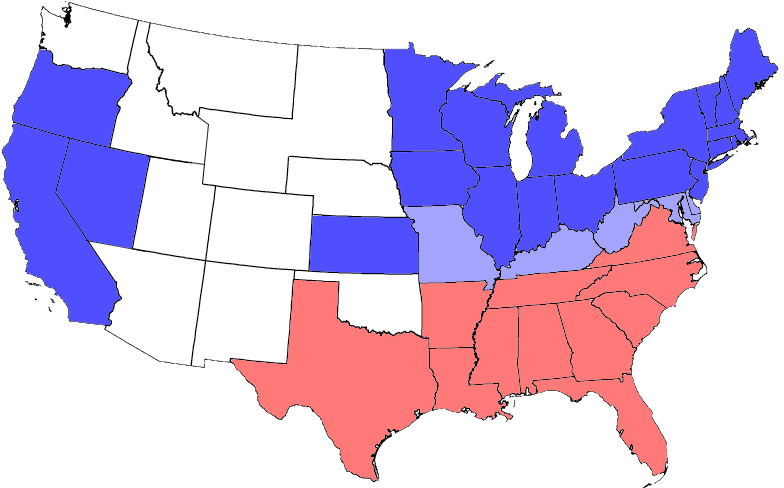 Startseite > Länder nach Kontinenten > Nordamerika > Vereinigte Staaten > Geschichte der USA > Border States
Startseite > Länder nach Kontinenten > Nordamerika > Vereinigte Staaten > Geschichte der USA > Border States
Border States

Nordamerika 1864: rot die Konföderierten Staaten, blau die Union; hellblau
Unionsstaaten mit Sklavenhaltung, die sogenannten Border Staes
In the context of the
American Civil War, the border states were
slave states that had not declared a secession from the
Union (the ones that did so later joined the
Confederacy). Four slave states had never declared a secession:
Delaware,
Kentucky,
Maryland, and
Missouri. Four others did not declare secession until after the
Battle of Fort Sumter:
Arkansas,
North Carolina,
Tennessee, and
Virginia—after which, they were less frequently called "border states".
Also included as a border state during the war is
West Virginia, which broke away from Virginia and became a new state in
the Union in 1863.
In all the border states there was a wide consensus
against military coercion of the Confederacy. When
Abraham Lincoln called for troops to march south to recapture Fort
Sumter and other national possessions, southern Unionists were dismayed.
Secessionists in Arkansas, North Carolina, Tennessee, and Virginia were
successful in getting those states to secede from the U.S. and to join the
Confederate States of America.
In Kentucky and Missouri, there were both
pro-Confederate and pro-Union governments. West Virginia was formed in
1862-63 from those northwestern counties of Virginia which had remained
loyal to the Union and set up a loyalist ("restored") state government of
Virginia. Though every slave state except
South Carolina contributed some white troops to the Union as well as the
Confederate side,[4]the
split was most severe in these border states. Sometimes men from the same
family fought on opposite sides. About 170,000 Border state men fought in
the Union army and 86,000 in the Confederate army[5]
Besides formal combat between regular armies, the
border region was the site of large-scale
guerrilla warfare among competing forces and numerous violent raids,
feuds and assassinations.[6][page needed]
Violence was especially severe in eastern Kentucky and western Missouri. The
single bloodiest episode was the 1863
Lawrence Massacre in Kansas, in which at least 150 civilian men and boys
were killed.[7][8][page needed][9]
With geographic, social, political, and economic
connections to both the North and the South, the border states were critical
to the outcome of the war. They are considered still to delineate the
cultural border that separates the North from the South.
Reconstruction, as directed by Congress, did not apply to the border
states because they never seceded from the Union. They did undergo their own
process of readjustment and political realignment after passage of
amendments abolishing slavery and granting citizenship and the right to vote
to freedmen. After 1880 most of these jurisdictions were dominated by white
Democrats, who passed laws to impose the
Jim Crow system of legal segregation and second-class citizenship for
blacks, although the freedmen and other blacks were allowed to continue to
vote.[10][page needed]
Lincoln's 1863
Emancipation Proclamation did not apply to the border states. Of the
states that were exempted from the Proclamation, Maryland (1864),[11]
Missouri (1865), Tennessee (1865),[13]
and West Virginia (1865)[14]
abolished slavery before the war ended. However, Delaware[15]
and Kentucky did not abolish slavery until December 1865, when the
Thirteenth Amendment was ratified.
Quellen
Bildernachweis
Weblinks